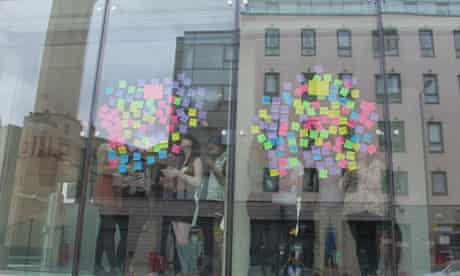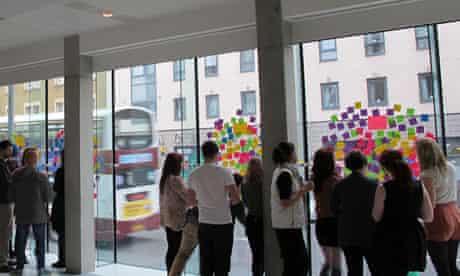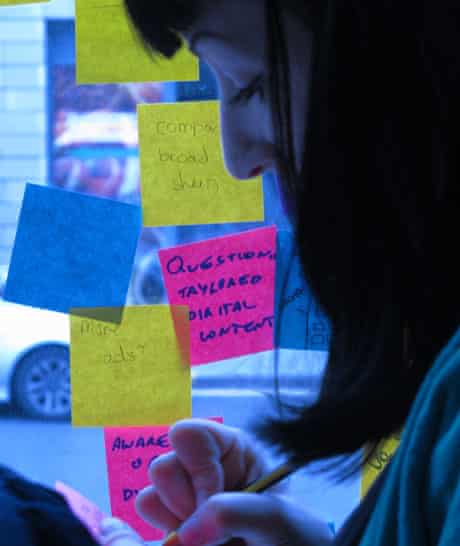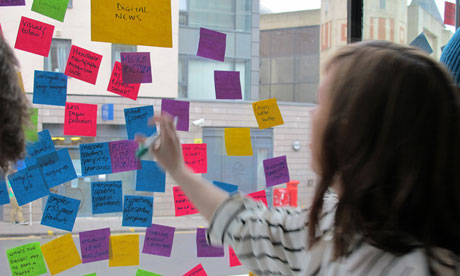Bright and early on 4 of November, two members of the Guardian’s Digital Development team headed up to Edinburgh to be part of Business:Designed. The event, organised by local group Student Designers, aimed to bring together 40 of Scotland’s young designers and challenge them to invent a business model for an idea they would collaboratively come up with on the day.
One of the eight business topics was “digital news”, and that’s where we came in. Our role was to provide help, feedback and guidance to the design students in the process of elaborating a business idea that would be innovative, doable, ambitious, and – most of all – new.
Matt Andrews, client-side developer, and Mariana Santos, interaction designer, were embedded among the students, sharing experiences, visions and dreams as the students stuck ideas and concepts onto the glass walls of the building, Edinburgh University’s Inspace laboratory.
As the day progressed there were hundreds of Post-it notes covering the walls, and gradually our job was to help the students whittle these down to a workable set of concepts and ideas relating to digital news.

From our perspective it was fun to challenge the students to think about the news domain in new ways. “Okay: what if we start by imagining there’s no such thing as a print newspaper. What impact would that have?” we asked them to start with. “What if everyone in Britain owned a smartphone or a tablet?” was another follow-up.
The students were really receptive to these ideas and began to generate creative and unique solutions. Some of the ideas repeated the most frequently by different groups were around things such as customisation: how could users could tailor the news to suit them; local/mobile: receiving news updates relative to your location and proximity; and social: how to share and discover information and content through your network of friends.

Gradually some consensus emerged about which ideas were strongest, and this was where organiser Alex Barton introduced the group to the Business Model Canvas and Customer Empathy Maps, which were taken from a book by Alex Osterwalder and Yves Pigneur.
Alex had previously tried this technique with business students, so it was an interesting result to see the designers working through the charts and diagrams. The ideas was that they were forced to picture their product’s customer – literally – and clarify their revenue sources, risks, outgoings, key resources and more.
As an observer this was fascinating to watch: by placing the user first and prioritising their needs and desires, this made the students really think about their products and what they could do. After thinking over our own hack days, the closest thing the Guardian does to the Business:Designed event, we certainly thought we had something to learn here.
The day culminated in each of the teams presenting their ideas to the group, using the Business Model Canvas as a jump-off point to produce nine massive Post-it notes which explained each aspect of the business.
We’d spent some of the afternoon catching up with other groups as well as the Digital News team, and some of the ideas were really creative and imaginative: we saw things such as an online doctor’s room for first year students with, ahem, embarrassing complaints; creative mixing of local community members with bus stop advertisements to form interactive advertising; an eBay-esque site where users could swap skills and knowledge; and a free bike rental scheme for students in Edinburgh.
Our own team, the Digital News group, came up with “col8”, a fantastically-named app that would “collate” news and features from a variety of sources around the web, tailored to an individual. Users could choose tags such as “fashion” or “politics” and see all the content for those tags from around the web.
The premium version would offer non-web content from publications without a free web presence, with the students’ business plan discussing the need to make syndication deals with content providers. There would be a free web app, a paid-for iPad app and we explored the “freemium” model and how advertising could help generate revenue.

Overall it was a really interesting opportunity for both parties – the students hopefully got to pick our brains about the challenges of digital news and the issues, competition and financial challenges that the industry faces. From the Guardian’s side, we got to hear a set of user needs, ideas and challenges that we’d never heard articulated before.
It was great to have some of our own ideas confirmed by the students, but even better to hear them come up with genuinely new and exciting twists on the digital news space. We had to promise our group that there wouldn’t be a “Guardian col8” app any time soon…
Alex’s goal with the event was to challenge the designers to put their money where their mouth was and come up with a viable business idea as well as simply a creative concept.
Many of the ideas that came out of the session sounded viable and interesting – it certainly felt like a Dragon’s Den environment as students challenged each other, and I half-wished we had a Duncan Bannatyne figure to declare “I’m in” for some of the strongest ones – it would have been really cool to see some of these things get prototyped even further. Here is a video showing highlights from the day.
The digital news space is an increasingly interesting area to observe and it was fantastic for the Guardian to hear the ideas of the people we’re calling “digital natives”. We hope they gained something from us, but it’s certain that we left Edinburgh feeling energised and excited by the potential we’d just seen that day. Now to build that col8 app …
